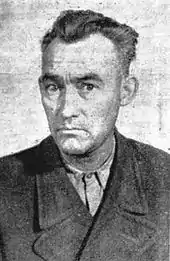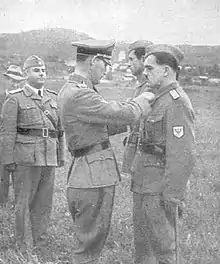Erwin Rösener
Erwin Friedrich Karl Rösener (2 February 1902 – 4 September 1946) was a German Schutzstaffel (SS) commander during the Nazi era. During World War II, he was responsible for mass executions of civilians in Slovenia. Rösener was put on trial for war crimes and sentenced to death on 30 August 1946, then executed by hanging on 4 September 1946. He was posthumously included in the indictment at the Nuremberg Trials for war crimes.

Early life and SS career
Rösener was born on 2 February 1902 in Schwerte, a town in the Westphalia. He joined the Nazi Party and the Sturmabteilung ("Brownshirts") paramilitary group on 6 November 1926. He applied to join the SS in October 1929 (his application was accepted in 1930). He was promoted 11 times between 1930 and 1944, eventually finishing with the rank of SS-Obergruppenführer and General of the Waffen-SS and Police. He was a member of the Freundeskreis der Wirtschaft, or "Circle of Friends of the Economy",[1] a group of German industrialists whose aim was to raise funds for racial research within Nazi Germany. He was a close associate of SS chief Heinrich Himmler, and reported directly to him during the war.[2]
War crimes in Yugoslavia
From the end of 1941 to the end of the war Himmler assigned Rösener as the Higher SS and Police Leader for SS-Oberabschnitt Alpenland, part of whose territory was Slovenia. Between October 1944 and the end of the war he was head of anti-Partisan warfare in Ljubljana. During both assignments he ordered the execution of civilians, hostages and prisoners of war,[3] actions which led to his name being on the indictment for war crimes at Nuremberg.[4]
Rösener worked closely with Leon Rupnik in fighting the Partisans,[5][6] and ordered the formation of the pro-Nazi Domobranci, the Slovenian Home Guard forces on 24 September 1943.[7] Rösener escaped to Austria after the war but was arrested by the British and returned to Yugoslavia. He was put on trial alongside Leon Rupnik and others, and was sentenced to death on 30 August 1946.[8] He was executed by hanging on 4 September 1946, and was buried the same day in an unmarked grave at Ljubljana's Žale cemetery.
Gallery
 SS Lieutenant-General Erwin Rösener giving medals to Slovene Home Guard soldiers c. 1944
SS Lieutenant-General Erwin Rösener giving medals to Slovene Home Guard soldiers c. 1944.jpg.webp) SD Inspector-General Leon Rupnik, Bishop Gregorij Rožman, and SS-General Erwin Rösener
SD Inspector-General Leon Rupnik, Bishop Gregorij Rožman, and SS-General Erwin Rösener.jpg.webp) SD Inspector-General Leon Rupnik, Bishop Gregorij Rožman, and SS-General Erwin Rösener, inspect Slovene Home Guard troops, after the second oath of allegiance, January 30, 1945
SD Inspector-General Leon Rupnik, Bishop Gregorij Rožman, and SS-General Erwin Rösener, inspect Slovene Home Guard troops, after the second oath of allegiance, January 30, 1945
References
- Freundeskreises des Reichsführers-SS
- "Higher SS and Police Leaders". Archived from the original on 2007-09-19. Retrieved 2007-11-20.
- One of Rösener's execution notices: http://shrani.si/files/0s3cj.jpg. It reads:
"Notice: It has been ascertained that the majority of the male inhabitants of the villages of Gradische (Gradišče pri Lukovici) and Koreno, Kreis Stein, have joined bands [of rebels], while the rest of the population have constantly supported them with reports and food and despite their knowledge of the location and activities of bandits not notified the authorities. For this reason, both villages have been destroyed by fire, the male inhabitants aged over 18 have been shot and the rest of the population evicted".
Other notices of large scale executions ordered by Rösener in June, July and November 1942: http://img462.imageshack.us/img462/570/banditenbekanntmachungsty1.jpg
"Archived copy". Archived from the original on 2011-10-02. Retrieved 2007-11-20.CS1 maint: archived copy as title (link) - Count 3(C) MURDER AND ILL-TREATMENT OF PRISONERS OF WAR: "In Yugoslavia the German Command and the occupying authorities in the person of the chief officials of the Police, the SS troops (Police Lieutenant General Rosener) and the Divisional Group Command (General Kubler and others) in the period 1941–43 ordered the shooting of prisoners of war". http://www.yale.edu/lawweb/avalon/imt/proc/count3.htm Archived 2007-12-17 at the Wayback Machine.
- Three photos of Leon Rupnik, Erwin Rösener and Gregorij Rožman. The first is outside Ljubljana central stadium on 20 April 1944 when the Domobranci swore oaths of allegiance; the last is on 30 January 1945 as the Domobranci paraded past after again swearing loyalty: http://muceniskapot.nuovaalabarda.org/galleria-slo-7.php
- Rupnik, Bishop Rožman and Rösener in conversation. Date and place unknown. "Archived copy". Archived from the original on 2011-10-02. Retrieved 2007-11-20.CS1 maint: archived copy as title (link)
- In his speech at the ceremony where the Domobranci swore loyalty on 20 April 1944, Rösener said "On 24 September 1943 I issued the command for the foundation of 'Slovensko domobranstvo'. From the few troops of the so-called White Guard legionnaires, as per my order, 'Slovensko domobranstvo' has grown. With the help of the Greater German Reich, we have trained, clothed and armed you. Today you have taken an oath, that you will, together with the German Army, the military SS and police fight for the freedom of all of Europe". Slovenec newspaper, 21 April 1944. See
http://www2.arnes.si/~ljgozzb1/javnost17.htm
http://www.sds.si/forum/viewtopic.php?id=1460&p=2%5B%5D
Here Rösener is seen awarding medals to Domobranci members: http://img266.imageshack.us/img266/5913/heimwehrrsnerri6.jpg - New York Times, 31 August 1946, page 3; see photocopies of reports